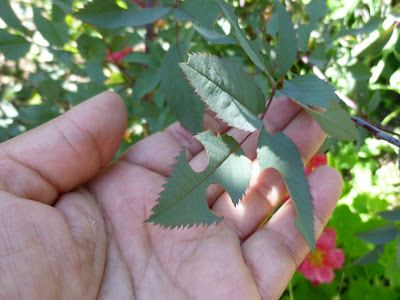It's been 28 days without rain in
Vancouver. The grass alongside the road in Westbrooke village
is brown and sere. There is a bit of a chill in the air and a
cloud bank moving in from the North, but I don't think it will rain
today. I decided it was going to be hot, so I dressed in my roomy Beespeaker pants, white blouse and pith helmet. I'm going on a bee
safari at UBC Farm.
When I arrive at the farm I go out in the gardens to see which
bee plants are blooming. The honeybees are already busy in the
oregano and the larger bumble bees are just waking up, slowly making
their way around the sunflowers, dahlias, echinops and monarda. When
the day heats up the bees will warm up and get more speedy and the
smaller bumble bee runts will join them. Those little 'uns can move
really fast--too fast for my camera. On the echinops I find a very
large elongated queen with a big bald spot in the middle of her
thorax. She also had bald patches on her sides from rubbing against
blossoms and possibly from rubbing against the side of the entrance
to her nest. You can see the big white pollen grains that have
collected on her fur.
I much prefer the fireworks of flowers to nocturnal pyrotechnics. These echinops are so much fun to photograph. I must plant some in my garden next year. They looks great with perovskia and sea holly.
When the sunflowers are blooming and the blackberries are ripe UBC Farm is the best place to be in Vancouver.
This sunflower has a lemon yellow pollen that matches what we call its petals, but are not actually its real petals.
Tepeas! The aboriginal community kitchen garden is looking great.
Take a walk on the wild side.
Garlic must be cured for several days before it is sold.
Fireweed is a great honey plant.
This is a classic bee plant--a variety of phacelia that can be planted as a cover crop.
This is one of the fuzziest bees I have ever seen. No bald spots here!
When the hairs get rubbed off the stripes are more delineated.
Hmmmm, I think I saw a painting of these somewhere.
At the market I meet Beekeeper
Stephanie, who is going to suit up and open the hives today. She is
very calm around the bees, and good at fielding questions. I pipe in
where I can add my two cents. We are very clear about warning people
that they must stay calm and move slowly around the hive and talk
about the dangers of being stung. The third time we open the hive,
the bees are getting agitated and one flies into a boys hoodie. He
panics because the bee is caught in his hair and before you know it
he's bee stung on the head. Oh dear. I tell him he'll be okay, only it will hurt like hell for 10 minutes and he'll never forget this
day. I remove the stinger, His mom chews up a plaintain leaf and
sticks it on the bump.
I have fun showing off the new trick I learned from beekeeper Brian Campbell--pressing on the backs of drones to see how they buzz. The younger the drone, the more soft its body is. Fun times!
People are asking great questions,
especially the kids. How do bees gather propolis? I'd never thought
about it. Ironically, when I research this "red shiny pollen"
on a bee's corbicles I realize I've photographed a bee carrying
propolis back to the hive. She has collected with her mandibles from
a tree and transferred it to her back legs. You can see the propolis on the left side of this photograph. It helps keep the hive hygienic. After reading this article on the Basic Beekeeping blog, I found out that some beekeepers used to discourage the making of propolis because it slowed down hive inspections. Now beekeepers are actually roughing up some of the wood in the hive to encourage the bees to smooth it out with propolis. I wonder if it plays a role in keeping out the varroa mite.
 | ||||
| Twin bees on a dahlia |
This is a good example of integrating vetch into a daisy patch to make it more biodiverse.
A trio of young boys squat in the grass and shoot me some tough questions. One of them has a fantastic imagination. "Are there flowers that are poisonous to bees? What is the electric fence for? What if the chicken touched the electric fence? Would it get burnt? Could we eat it for dinner?"
"Call the firetruck!" his younger brother cries, keen for some excitment.
Well, roasted chickens aside, I was very excited to learn from one of the interns that the Agroforestry department has planted a bee hedgerow at UBC Farm! I must go back to check it out and take some photos. Check out the information here.

























































